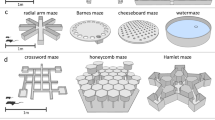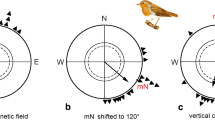Abstract
This paper considers the problem of environment-mapping for autonomous mobile agents. Central to this problem is how the structure of the external environment can be captured and represented so that an agent is able to autonomously navigate in a robust way. This is an issue that is not clear even given a perfect sensor system that provides all information that the agent needs. Biological data reveal that the activation of hippocampal place cells in an animal, which is performing navigational tasks, is highly correlated with the animal's location, and the sensory basis of place cell firing is of multiple modalities which include landmark detection. As a functional approximation to hippocampal place learning, this paper presents a dynamic network that can be used by an autonomous agent to map landmarks, places and the spatial relation between them. The spatial relation is encoded by embedding an areal coordinate coding principle into the inter-cell connection structure. For the network to be used to map a large space, a focusing mechanism is introduced, which not only constrains the scope of the network in which learning can take place, but also limits the computation needed to the part of the network that is currently relevant to the activity of the agent. This focusing mechanism can also be used to direct dynamic route-finding in the network that the agent builds. Simulation results of the network demonstrate its applicability and computational characteristics.
Similar content being viewed by others
References
Bachelder, I.A. and Waxman, A.M. 1995. A view-based neurocomputational system for relational map-making and navigation in visual environments. Robotics and Autonomous Systems, 16:267-289.
Blair, H.T. and Sharp, P. 1995. Anticipatory head direction signals in anterior thalamus: Evidence for a thalamocortical circuit that integrates angular head motion to compute head direction. J. Neuroscience, 15(9):6260-6270.
Blum, K.I. and Abbott, L.F. 1996. A model of spatial map formation in the hippocampus of the rat. Neural Computation, 8:85-93.
Burgess, N., Jeffery, K.J., and O'Keefe, J. 1999. Integrating hippocampal and parietal functions: A spatial point of view. In The Hippocampal and Parietal Foundations of Spatial Cognition, N. Burgess, K.J. Jeffery, and J. O'Keefe (Eds.), Oxford University Press, pp. 3-29.
Burgess, N., Recce, M., and O'Keefe, J. 1994. A model of hippocampal function. Neural Network, 7(6/7):1065-1081.
Chen, L.L., Lin, L., Barnes, C.A., and McNaughton, B.L. 1994b. Head-direction cells in the rat posterior cortex: II. Contributions of visual and ideothetic information to the directional firing. Exp. Brain Res., 101:24-34.
Chen, L.L., Lin, L., Green, E.J., Barnes, C.A., and McNaughton, B.L. 1994a. Head-direction cells in the rat posterior cortex: I. Anatomical distribution and behavioral modulation. Exp. Brain Res., 101:8-23.
Cressant, A., Muller, R.U., and Poucet, B. 1997. Failure of centrally placed objects to control the firing fields of hippocampal place cells. J. Neuroscience, 17:2531-2542.
Franz, M.O., Schőlkof, B., Mallot, H.A., and Bűlthoff, H.H. 1998. Learning view graphs for robot navigation. Autonomous Robots, 5:111-125.
Gerstner, W. and Abbott, L.F. 1997. Learning navigational maps through potentiation and modulation of hippocampal place cells. J. Computational Neuroscience, 4:79-94.
Hill, A.J. and Best, P.J. 1981. Effects of deafness and blindness on the spatial correlates of hippocampal unit-activity in the rat. Exp. Neurology, 74:204-217.
Knierim, J.J., Kudrimoti, H.S., and McNaughton, B.L. 1995. Place cells, head direction cells, and the learning of landmark stability. J. Neuroscience, 15(3):1648-1659.
Kubie, J.L. and Muller, R.U. 1991. Multiple representation in the hippocampus. Hippocampus, 1(3):240-242.
Kurz, A. 1996. Constructing maps for mobile robot navigation based on ultrasonic range data. IEEE Trans. on System, Man and Cybernetics Part B, 26(2):233-242.
Li, G., Svensson, B., and Lansner, A. 1998. Self-orienting with on-line learning of environmental features. Adaptive Behavior, 6(3/4):535-566.
Maguire, E.A., Burgess, N., Donnett, J.G., Frakowiak, R., Frith, C.D., and O'Keefe, J. 1998. Knowing where and getting there: A human navigation network. Science, 280:921-924.
Maguire, E.A., Frackowiak, R.S., and Frith, C.D. 1997. Activation of the right hippocampus in taxi drivers. J. Neuroscience, 17(18):7103-7110.
Mataric, M. 1992. Integration of representation into goal-driven behavior-based robots. IEEE Trans. Robot. Automat., 8(3):304-312.
McNaughton, B.L., Chen, L.L., and Markus, E.J. 1991. Dead reckoning, landmark learning, and the sense of direction: A neurophysilogical and computational hypothesis. J. Cognitive Neuroscience, 3:190-202.
McNaughton, B.L. and Nadel, L. 1990. Hebb-Marr networks and the neurobiological representation of action in space. In Neuroscience and Connectionist Theory, M.A. Gluck and D.E. Rumelhart (Eds.), Lawrence Erlbaum Associates: Hillsdale, NJ.
Mizumori, S.J.Y. and Williams, J.D. 1992. Interdependence of hippocampal and lateral dorsal thalamic representations of space. Soc. Neurosci. Abstr., 18:708.
Mizumori S.J.Y. and Williams, J.D. 1993. Directionally selective mnemonic properties of neurons in the lateral dorsal nucleus of the thalamus of rats. J. Neuroscience, 13(9):4015-4028.
Muller, R.U., Stead, M., and Pach, J. 1996. The hippocampus as a cognitive graph. Journal of General Physiology, 107:663-694.
O'Keefe, J. 1976. Place units in the hippocampus of the freely moving rat. Exp. Neurol., 51:78-109.
O'Keefe, J. and Burgess, N. 1996. Geometric determinants of the place fields of hippocampal neurones. Nature, 381:425-428.
O'Keefe, J. and Dostrovsky, J. 1971. The hippocampus as a spatial map: Preliminary evidence from unit activity in the freely moving rat. Brain Res., 34:171-175.
O'Keefe, J. and Nadel, L. 1978. The Hippocampus as a Cognitive Map. Oxford University Press: Oxford.
O'Keefe, J. and Speakman, A. 1987. Single unit activity in rat hippocampus during a spatial memory task. Experimental Brain Research, 68:1-27.
Oore, S., Hinton, G.E., and Dudek, G. 1997. A mobile robot that learns its place. Neural Computation, 9:683-699.
Prescott, T.J. 1996. Spatial representation for navigation in animates. Adaptive Behavior, 4(2):85-123.
Recce, M. and Harris, K.D. 1996. Memory for places: A navigational model in support of Marr's theory of hippocampal function. Hippocampus, 6:735-748.
Schőlkopf, B. and Mallot, H.A. 1995. View-based cognitive mapping and path planning. Adaptive Behavior, 3(3):311-348.
Skaggs, W.E., Knierim, J.J., Kudrimoti, H.S., and McNaughton, B.L. 1995. A model of the neural basis of the rat's sense of direction. In Advances in Neural Information Processing Systems 7, G. Tesauro, D.S. Touretzky, and T.K. Leen (Eds.), MIT Press: MA, pp. 173-180.
Steinhage, A. and Schőner, G. 1997. Self-calibration based on invariant view recognition: Dynamic approach to navigation. Robotics and Autonomous Systems, 20:133-156.
Taube, J.S. 1995. Head direction cells recorded in the anterior thalamic nuclei of freely moving rats. J. Neuroscience, 15(1):70-86.
Taube, J.S. and Burton, H.L. 1995. Head direction cell activity monitored in a novel environment and during a cue conflict situation. J. Neurophysiol, 74:1953-1971.
Taube, J.S. and Muller, R.U. 1995. Head direction cell activity in the anterior thalamic nuclei, but not the post-subiculum, predicts the animal's future directional heading. Soc. Neurosci. Abstr., 21:946.
Taube, J.S., Muller, R.U., and Ranck, J.B. 1990. Head-direction cells recorded from the postsubiculum in freely moving rats. I. Description and quantitative analysis. J. Neuroscience, 10:420-435.
Wilson, M.A. and McNaughton, B.L. 1993. Dynamics of the hippocampal ensemble code for space. Science, 261:1055-1058.
Yamauchi, B. and Beer, R. 1996. Spatial learning for navigation in dynamic environments. IEEE Trans. SMC-Part B: Cybernetics, 26(3):496-505.
Zhang, K. 1996. Representation of spatial orientation by the intrinsic dynamics of the head-direction cell ensemble: A theory. J. Neuroscience, 16(6):2112-2116.
Zimmer, U.R. 1996. Robust world-modelling and navigation in a real world. Neurocomputing, 13(2/4):247-260.
Zipser, D. 1986. Biologically plausible models of place recognition and place location. In Parallel Distributed Processing: Explorations in the Micro-Structure of Cognition, J.L. McClelland and D.E. Rumelhart (Eds.), Bradford Books: Cambridge, MA, Vol. 2, pp. 432-470.
Author information
Authors and Affiliations
Rights and permissions
About this article
Cite this article
Li, G., Svenson, B. Navigating with a Focus-Directed Mapping Network. Autonomous Robots 7, 9–30 (1999). https://doi.org/10.1023/A:1008961628456
Issue Date:
DOI: https://doi.org/10.1023/A:1008961628456




